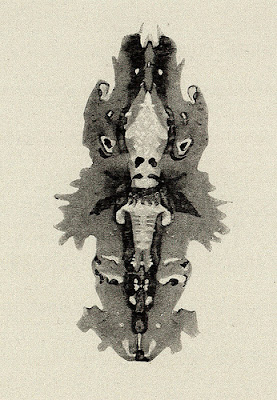"Médico, poeta, visionario: con estos tres calificativos define a nuestro personaje su biógrafo Otto Joachim Grüsser1, y cualquiera que conozca sumariamente la vida de este personaje del Romanticismo alemán reconocerá que le hace justicia. Esa triple vertiente de su personalidad, desplegada por lo general en los campos correspondientes —como médico estudió con gran finura el botulismo; como poeta, al lado de Uhland, es cabeza del romanticismo suabo; como visionario se hará célebre con el caso de la vidente de Prevorst— se manifiesta de manera conjunta y armoniosa, al final de su vida, en esas curiosas producciones de las que pretendo mostrar algunos ejemplos en este trabajo: las kleksografías.



«Kleksographien» es el nombre dado por Kerner a figuras como las que aquí se muestran; un neologismo no acuñado por él mismo, sino por «un ingenioso amigo del arte y del humor» cuya identidad desconocemos. Después de considerar varias opciones he optado por la mera adaptación al español, pues la traducción del vocablo alemán «Kleks» —borrón, mancha de tinta— habría producido engendros como «borronografías» o «manchografías»; la opción «maculografías» quedaba descartada por el hecho de que el propio Kerner podría haber utilizado el vocablo latino de haber querido...
En su breve introducción a la edición existente de algunas kleksografías,
Justinus Kerner nos explica cómo su creciente pérdida de visión, debida a cataratas, ha provocado, por una parte, una mayor torpeza al escribir, que se traduce en profusión de borrones, y por otra en la toma en consideración de las caprichosas formas, aún bien perceptibles para él, que adoptan las gotas de tinta sobre el papel inutilizado para la escritura después de plegarlo del mismo modo que, como ahora recuerda, hacían a veces otros escolares y él mismo en la lejana infancia para divertirse con semejantes productos del azar. La semejanza de este proceder con el test de
Rorschach ha sido generalmente reconocida, hasta convertirse en un lugar común. Sin embargo, no he conseguido encontrar un testimonio explícito a este respecto. El autor de referencia en la historia de la «psiquiatría dinámica», Henri F. Ellenberger, da por sentada la influencia de las kleksografías de Kerner, pero sin aportar prueba alguna. Y el propio Rorschach sólo de refilón emplea dicho neologismo sin siquiera asociarlo al médico romántico.
Con todo, algo hay en el origen de estas «kleksografías» que escapa a la propia voluntad y que, por lo tanto, les confiere esa cualidad misteriosa que su autor reconoce en dos de los primeros poemas:
De la muerte los heraldos
desde la noche de tinta
traen del Hades los grabados.
(¡Corazón, nada sabías!).
***********************
Estas figuras del Hades,
negras, que me traen temores,
son espíritus menores;
por sus solas fuerzas nacen.
Para espantarme, sucintas,
brotan de manchas de tinta.
Así, siempre pienso en ellas
en la noche, en las tinieblas."
La fuente del texto anterior es el artículo sobre
Kleksographien por Luis Montiel titulado "KLEKSOGRAFÍAS DE JUSTINUS KERNER SELECCIÓN, TRADUCCIÓN Y ESTUDIO PRELIMINAR":
http://www.frenia-historiapsiquiatria.com/pdf/fasciculo%204/121-kleksografias-de-justinus-kerner-seleccion-traduccion-y-estudio-preliminar.pdf
Ver libro
Kleksographien entero en la Web:
http://digi.ub.uni-heidelberg.de/diglit/kerner1890/































